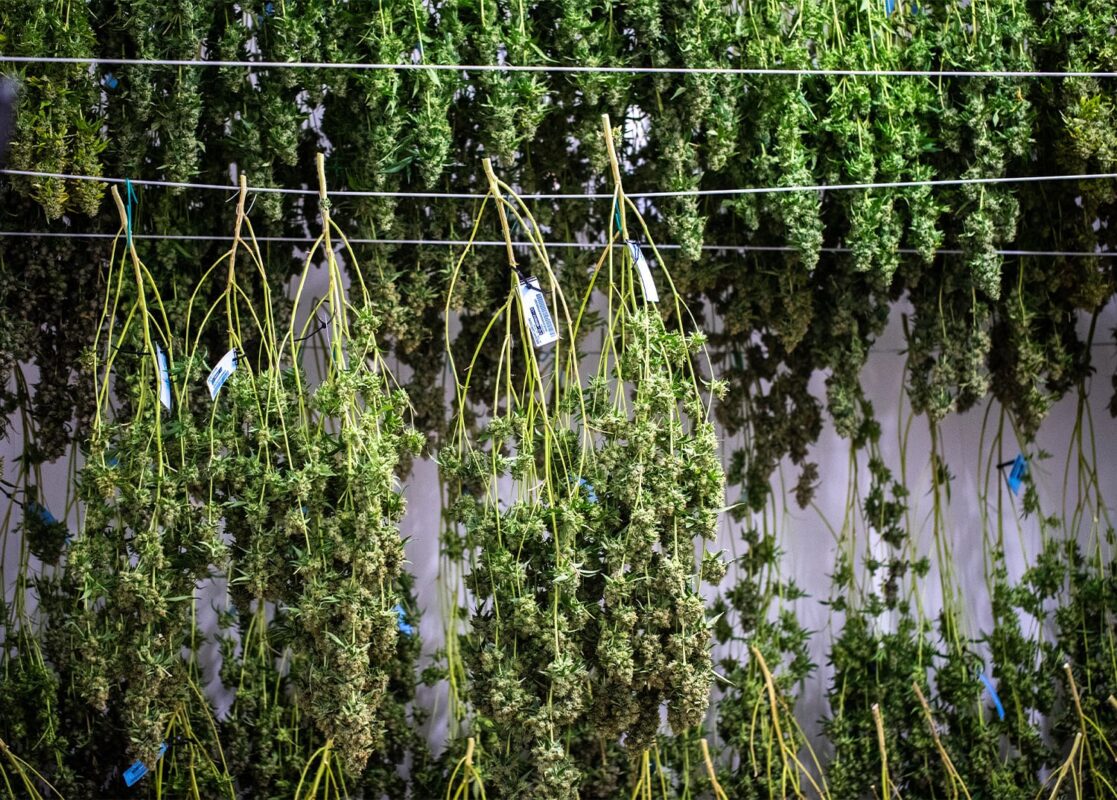Uncategorized
How to Dry Cannabis? Mastering Drying and Curing for Optimal Quality
How to dry cannabis? After harvesting marijuana plants, undergoing proper drying and curing processes is essential for the buds. These methods aim to enhance and maintain flavors by retaining terpenes and cannabinoids while reducing chlorophyll content and eliminating the plant’s vegetal taste.
Drying is the initial phase where buds are dried, typically in the open air. Freshly harvested plants can lose up to 75% of their weight due to moisture loss, along with the removal of sticks, stems, branches, and leaves.
In dry trimming, drying precedes trimming, while in wet trimming, it’s the other way around. The drying duration shouldn’t be too short or too long: a rapid drying may result in the outer layer appearing dry while the interior remains moist, while prolonged drying could lead to mold formation.
Following trimming and drying, the buds are sealed in airtight containers for curing. This process halts moisture loss, preserving flavors and aromas and allowing the buds to develop their full flavor profile.
How Much Time Is Needed to Dry Marijuana?
Drying typically lasts between 2 to 7 days. If wet trimming is employed, where most of the plant material is removed beforehand, the process tends to be shorter due to less material needing drying.
For dry trimming, harvested plants or branches are hung upside down on a line or hanger to maintain bud shape during drying. In wet trimming, trimmed buds are placed on a drying rack.
Regardless of trimming method, check the drying progress after two days by bending a branch or stem. If it snaps, the buds are fully dry. If not, continue checking daily until they do.

Creating a Cannabis Drying Space
Creating an Effective Drying Room
A well-functioning drying room should maintain a dim environment with temperatures ranging between 60-70°F and humidity levels between 55-65%. Utilizing an inexpensive hygrometer can aid in keeping track of these parameters.
It’s important to consider the constraints of your available space for drying, as larger rooms may pose challenges in controlling temperature and humidity. Additionally, be prepared for the distinct aroma of cannabis in the room. Select a space with minimal temperature and humidity fluctuations.
Integrating a small fan to enhance air circulation is beneficial, and you might find it necessary to incorporate a dehumidifier or air conditioning unit. If drying times seem prolonged, adjusting the temperature or humidity settings can facilitate the drying process.
Ideal Light Conditions for a Drying Room
Sunlight’s UV rays can break down cannabis, so it’s best to keep the drying area dark for optimal results. If your space isn’t completely light-proof, cover the buds. While it’s fine to open the door occasionally to check on them, extended exposure to light can speed up the drying process.
Equipment for Drying Cannabis
- Drying rack or hanging line for drying buds
- Device to gauge temperature and humidity
- Air circulation fan
- Optional air conditioning unit
- Optional moisture remover
Hanging Buds to Dry
Drying buds by hanging is less demanding in terms of labor but requires more space. This method entails trimming large branches or suspending entire plants upside down. While it saves time by eliminating the need to individually remove buds from branches, it occupies more space due to the increased amount of plant material being dried. Additionally, the presence of branches, stems, stalks, and fan leaves may prolong the drying process for buds.
Alternative Methods for Drying Buds: Beyond Hanging on a Line
When trimming buds while they’re still wet, you’ll require a flat rack since you’ll have numerous trimmed individual buds that can’t be hung. These racks are circular with mesh layers, facilitating airflow.
After 2-3 days, assess the wet-trimmed buds drying on the flat rack by gently pressing them. If they remain excessively wet, let them be and recheck the following day.
Treating Cannabis Addiction
Once the buds have completed the drying process and undergone trimming, they have released their initial moisture content, signaling the start of the curing cannabis phase for your cannabis. During curing, the finalized buds are placed in containers, usually airtight glass jars, to prevent moisture loss and maintain their flavors and aromas. This curing process typically spans from two weeks to a month, with the humidity level inside the containers ideally maintained between 55% and 65%.
Harnessing the Benefits of Proper Cannabis Curing
The curing process is often overlooked in cannabis cultivation, yet it holds significant importance. During curing, moisture migrates from the center of the bud outward. This process profoundly influences the flavor and quality of the cannabis smoke. Terpenes, responsible for the distinct aroma and taste of cannabis, are particularly sensitive and can degrade even at low temperatures, such as 50°F. Slow curing at cooler temperatures preserves terpenes better compared to fast, high-temperature drying weed methods.
Moreover, a proper curing regimen enables long-term storage of cannabis without concerns about mold or degradation of cannabinoids and terpenes. Well-cured flower can be safely stored in an airtight container in a cool, dark environment for up to two years without significant loss of potency.
How Weed Curing Affects Cannabis Quality
Curing enhances the final qualities of buds, enhancing their flavor and aroma. Throughout the curing process, chlorophyll degradation occurs, eliminating any vegetal taste that might be present. Without curing, cannabis would have a grassy flavor resembling freshly cut lawn. The reduction of chlorophyll content results in smoother and less harsh smoking experience.
Essential Gear for Curing Marijuana
When curing cannabis, it’s best to use a room or area with consistent temperature and humidity levels. Damp basements or hot attics aren’t suitable. The environment should stay at room temperature without excess humidity.
Light exposure can degrade terpenes, so it’s beneficial to have the option to switch off lights or cover jars to prevent light infiltration.
For curing buds, essential items include:
- Sealed jars
- Hygrometers (for each jar) to monitor temperature and humidity

The Art of Curing Cannabis Buds
What is the best way to dry marijuana? After drying, the next step is to cure the buds. Transfer the trimmed buds into a sealed container, typically glass mason jars, ceramic, metal, or wood vessels. Avoid plastic bags as they aren’t airtight and can impart unwanted flavors.
Ensure the buds are loosely packed in the containers without being compressed. Seal the containers and store them in a cool, dry, and dark location. Within a day or two, you’ll observe the buds becoming slightly softer as moisture redistributes within them. If this softening doesn’t occur, it suggests over-drying.
Maintain humidity levels inside the sealed jars at 55-65%. If uncertain, consider purchasing a digital hygrometer to measure moisture levels, available at hardware stores for around $20. To adjust humidity, use humidity packs like Boveda packs to rehydrate severely dry buds or leave the lid off for a period if buds are too wet. Regularly monitor and adjust humidity levels as needed.
Release Trapped Air from Your Beverages
During the initial curing week, irrespective of humidity, remember to open the containers briefly once or twice daily—a process known as “burping.” This action helps to release excess moisture and introduce fresh oxygen into the container.
If you detect an ammonia scent upon opening, it indicates insufficient drying and the presence of anaerobic bacteria, risking mold formation. Leave the lid off for a day and seal again tomorrow.
Following the initial week, burp the containers just once every few days.
Drying Marijuana: How Long Does It Take?
After being stored in containers for a period ranging from two to four weeks, your cannabis should undergo sufficient curing to provide a rich, fragrant, and high-quality experience. Certain individuals opt for curing durations extending from four to eight weeks, while specific strains may derive additional benefits from being cured for six months or longer.
Storing Your Harvested Cannabis Buds
After curing cannabis, you can keep the buds for up to two years without much potency loss. Similar to aged wine or whiskey, properly dried and cured cannabis should be stored in a cool, dark place—since mildew and molds flourish in temperatures between 77-86°F.
Excessive heat can dry out the cannabinoids and terpenes developed over months, resulting in a harsh smoke. To store your buds effectively:
- Keep them away from direct sunlight in a cool, dry spot.
- Use neutral containers like glass mason jars.
- Control humidity levels with hygrometers or products like Boveda packs.
- Minimize oxygen exposure by vacuum-sealing containers.
- Store different strains separately to maintain their unique flavors, and label them with dates to prevent mixing them up.
Temperature
Temperature influences the conversion of THCA to THC, the psychoactive compound in cannabis, with lower temperatures slowing down this process. THC gradually degrades into CBN, which has different effects. Additionally, warm air holds more moisture compared to cold air.
Humidity
Maintaining humidity between 55-65% is crucial for preventing mildew and mold from contaminating your cannabis. This humidity range also helps preserve the color, texture, scent, and taste of the buds.
Light
Exposure to light, especially UV rays, can degrade cannabis over time by breaking down its organic and synthetic components. Storing cannabis away from direct light not only protects it from harmful UV rays but also helps regulate temperature.
FAQ on Drying and Curing Cannabis Buds
How Can You Expedite the Drying and Curing Process?
For optimal flavor and smoothness, it’s best to take your time with drying and curing. Utilizing equipment like fans, ACs, and dehumidifiers can aid in controlling temperature and humidity levels during the process.
What Is the Ideal Humidity Level for Drying Buds Before Curing?
Maintain humidity levels between 55-65%, along with temperatures ranging from 60-70°F.
Is It Necessary for Buds to Be Completely Dry Before Curing?
Avoid letting buds become completely dry before curing to prevent harsh smoke. Drying should remove most moisture, with additional moisture being extracted during curing.
How Should You Handle Sticky Buds During Drying?
Sticky buds, indicative of high trichome content, should be dried using standard methods like a drying rack or hang drying.
What Does “Burping Weed” Mean in the Curing Process?
“Burping” involves periodically opening the curing jar to release excess moisture and introduce fresh oxygen, crucial for proper curing.
Why Is Burping Weed Important?
Regularly releasing moisture and replenishing oxygen prevents mold growth and ensures the preservation of desired qualities in the buds.
Does Curing Enhance the Taste of Cannabis?
Yes, curing aids in refining the taste, flavor, and aroma of cannabis by removing residual moisture and breaking down chlorophyll for a smoother smoking experience.
Is It Recommended to Use a Fan During Cannabis Drying?
Fans can be beneficial for maintaining optimal drying conditions by regulating temperature and humidity, especially if the drying space exceeds the recommended ranges.


